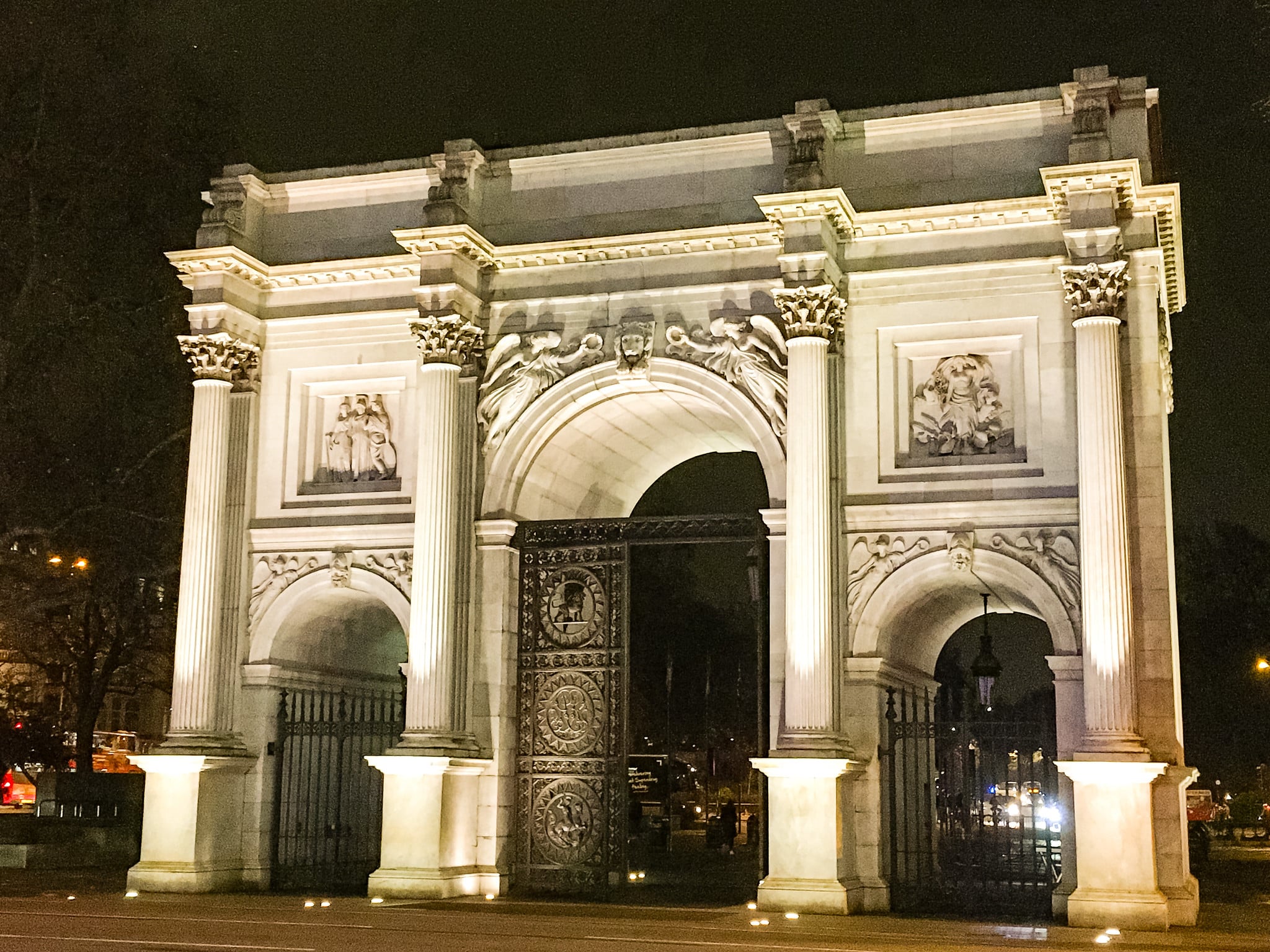Marble Archlocated in the north-east corner of Hyde Park near Speaker's Corner, is a must-see in London.
Today, I'd like to tell you more about this exceptional place.
Marble Arch: article summary
Marble Arch: an architect at work
In 1827, John Nash set to work designing the three-arch structure. It is based on the Arc of Constantine in Rome and the Arc de Triomphe du Carrousel in Paris.
Nash was one of Britain's most celebrated architects of the Georgian and Regency periods.
Although the historical architects are not very famous, their work speaks for itself.
You're bound to have heard of Nash. In fact, he's the architect behind some of London's most important buildings, including :
- Park Crescent
- Carlton House
- Regent Street
- Trafalgar Square
- King's Opera House
- King's Road

Symbolic sculpted reliefs
A relief is a sculpture that is carved into a surface or wall and therefore appears to be attached to it. In the case of Marble Arch, classic motifs are carved in Ravaccione, a type of Carrara marble native to Italy.
On the north side, you will find reliefs of three female figures representing England, Ireland and Scotlandsculpted by Richard Westmacott. Westmacott also created the statue of Achilles in Hyde Park Corner.
The bas-relief is as follows:
- The woman in the center is England, wearing the helmet of Britannia
- On the left, Ireland holds a harp
- On the right, Scotland holds the Saint-André shield.
The south side of Marcle Arch is full of meaning
On this south side, you'll find "Peace with War Trophies", two female figures, or angels, sculpted by EH Baily, who sculpted Nelson in Trafalgar Square.
The angel on the left is the angel of peace and abundance. The angel on the right is virtue and value. The flame between them is a symbol of freedom.
Marble Arch: a displaced arch
The monument was commissioned to be the official entrance to the Court of Honour at Buckingham Palace, which is not where it currently stands.
It was in 1851 that architect and urban planner Decimus Burton, a pupil of John Nash, had the idea of moving to its current site.
In the 1960s, Park Lane was widened and the site on which Marble Arch stands became a crossroads.
Myths about the reasons for the move
The myth that the monument's rooms were used as a police station is not the only myth surrounding this historic lighthouse.
Another reason is that the reason Marble Arch was moved to Park Lane from the Buckingham Palace was that Queen Victoria's state carriage was too wide to fit through the arch.
However, this was disproved at Queen Victoria's coronation procession, where it slipped through the arch en route to Westminster Abbey in 1838, and the coronation procession of Queen Elizabeth II had no problems in 1953.
Marble Arch: a police station?
There are three small rooms inside the rebuilt arch. From 1851 to 1968, these rooms mainly housed the Royal Park Service and later the Metropolitan Police.
This led people to speculate that Marble Arch was therefore a "police station", but that's not quite the case.
For a location to be considered an "active police station", it would have to be a place where crimes can be reported and equipped with holding cells or interrogation rooms.
Marble Arch cash flow problems
King George IV, who commissioned the design and construction of Marble Arch, had a reputation for being a big spender.
So he didn't hesitate to involve John Nash in the design. When William IV became king, he asked the architect who had replaced Nash, Edward Blore, to remove a large part of the decorations and the entire attic in order to cut costs.
Once he had brought the costs down to the budget he deemed appropriate, construction began.
As with many London landmarks, Marble Arch has a rich and eventful history. During your visit, don't hesitate to take a look at its history. to discover this exceptional arch in the heart of London.
What to do in London in 1 day, 2 days, 3 days, 5 days, a week?
Whatever the length of your stay, I invite you to download my special London guide.
It's free and in PDF format.
All you have to do is tell me below which e-mail address you'd like to receive it at.
EDIT: you can't enter your email?
Take the quiz at the top of this article and you'll be able to register your email address to receive the special London guide!
Hello, apparently Marble arch was moved in 1851 to its current location ( north east of hyde park ) because queen Victoria didn't find the monument to her taste , is this true ?
Hello Alex! It's true that the Marble Arch was moved in 1851, but the precise reason for this move is not officially that Queen Victoria didn't find it to her taste - although this version exists in some anecdotes. Several practical reasons are given, such as the fact that the arch was no longer suitable as a main entrance after the palace was remodeled.